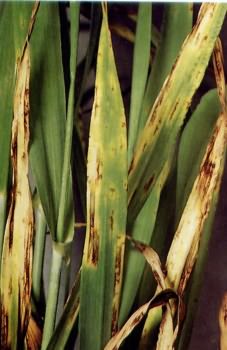Diseases
Net blotch of barley - Pyrenophora teres Drechsler (anamorph Drechslera teres (Sacc.) Shoemaker); synonym Helminthosporium teres Sacc.
Systematic position.
Anamorth: Class: Hyphomycetes, Order: Hyphomycetales, Family: Dematiaceae, Genus Drechslera. Teleomorph: Nlass: Loculoascomycetes, Subclass: Loculoascomycetidae, Order: Dothidealis, Famaly: Pleosporacea, Genus Pyrenophora.Biological group
Hemibiotrophic parasite, attacks cultivated barley and a few wild Hordeum species.Morphology and biology
Net blotch is named for the netlike symptoms produced on barley leaves. On adult plants, narrow, dark brown, longitudinal and transverse striations appear, forming the characteristic netlike pattern. Severely infected leaves may become completely necrotic and dry up. P. teres exists in two forms: P. teres f. teres, which causes the net type symptom on barley leaves, and P. teres f. maculate, which causes the spot type symptom. Spot type symptoms are characterized by dark brown, circular to elliptical (3 x 6 mm) spots, surrounded by a chlorotic zone of varying width. The development of different lesion types depends on the barley genotype and the isolate of the pathogen. In addition to the leaves, P. teres can also affect kernels, leaf sheaths and stems of barley plants. Conidiophores usually arise directly, from between epidermal cells, or from stomata, singly or in groups of 2 or 3. They are bulbous at the base. At their inception they are sub-hyaline; shortly afterwards they develop a fuliginous color (200 - 7-11.m). Conidia are cylindrical and straight, hyaline to subhyaline with 1-14 septa (70-160 x 16-23 .m). The pseudothecia are 1-2 mm in diameter and are covered with dark setae. Asci (30-61 x 180-274 .m) are club-shaped, rounded at the apex. Ascospores (18-28 x 43-61.m) are light brown and ellipsoidal and often have 3-4 transverse septa and one longitudinal septa in the median cell. P. teres also produces pycnidia in host tissue and in culture. Pycnidia are globose to pear-shaped, 64-172 .m in diameter, yellow to brown. Pycnidiospores (1.0-1.9 x 1.4-3.2 .m) are hyaline, nonseptate and spherical. The function of the pycnidial stage is not known. P. teres survives as seed born mycelium or as pseudothecia in infested host residue, or in infected winter barley. Conidia produced on the surface of primary lesions serve as secondary inoculum. Incubation period depends on weather conditions and takes from 20 hours to 20 days. Severe infection kills leaves prematurely and causes reduced seed weight. It may also reduce the number of ears and the number of grains per ear. Populations of pathogen are highly heterogenic on virulence.Distribution
Disease is widely distributed throughout the world. In NIS countries, it is found in areas where barley is cultivated.Ecology
Sporulation occurs when the relative humidity is near 100%, at temperatures from 15 to 25.C, with an optimum at 22.C. Infection of barley leaves is greatest when humid conditions persist for 10-30 hr or longer. The next generation of conidia is formed after 5-20 days. Conidia are distributed by wind or by rain.Economic significance
P. teres is most important in the Northern Caucasus, North-West and Central Regions of Non Chernozem Region, South Ural, Far East, in the Baltic region (Latvia, Lithuania) Belarus, Ukraine, and Kazakhstan. In these regions an epidemic appears every 4-5 years per decade. Yield losses owing to epidemics are estimated at 36-45%.Reference citations:
Gaike M.V. 1976. Perspectives of barley breeding in Latviiskaya SSR and resources for improvement. Summary of the PhD thesis, Leningrad. 28 pp. (In Russian)Hasanov B.A. 1992. Imperfect fungi are the causal agents of the main cereal diseases in Middle Asia and Kazakhstan. Summary of the Doc. thesis, Moscow. 44 pp. (In Russian)
Ishkova T.I., Berestetskaia L.I., Gasich E.L., Levitin M.M., Vlasov D.U. 2000. Diagnostic of the main diseases of cereals. Saint Petersburg, 76 pp. (In Russian)
Kashemirova L.A. 1995. Phytosanitary diagnostic systems of spring barley protection against spot and net "Helminthosporium" blotches. Summary of the PhD thesis, Moscow. 20 pp. (In Russian)
Klimenko O.P. 1994. Structure of causal agents of barley net and spot blotches on virulence and methods of artificial infection phones for.- Summary of the PhD thesis. Kiev, 20 p, (in Russian).
Kushnirenko I.U. 1987. Net blotch of barley in South Ural region and resources for breeding of resistance varieties. Summary of the PhD thesis, Leningrad. 20 pp. (In Russian)
Mathre D.E., ed. 1997. Compendium of barley diseases. APS PRESS. 90 pp.
Novozilov K.V., Zakharenko V.A., eds. 2000. Levels and tendencies of variability of species composition and intrapopulation structure, areas of complexes of harmful and useful organisms and forecast of dangerous phytosanitary situations on zones of the country. St. Petersburg. 100 pp. (In Russian)
Sanin S.S. 1995. Phytosanitary monitoring: modern state and ways of improvement. In: Novozhilov K.V., editor-in-chief. Problems of Optimization of Phytosanitary State in Plant Industry. Proceeding of All-Russian Meeting on Plant Protection. St. Petersburg: RASKhN, VIZR. 166-175 pp. (In Russian)
© Afanasenko O.C.


